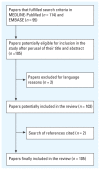Case-crossover analysis of air pollution health effects: a systematic review of methodology and application
- PMID: 20356818
- PMCID: PMC2920078
- DOI: 10.1289/ehp.0901485
Case-crossover analysis of air pollution health effects: a systematic review of methodology and application
Abstract
Background: Case-crossover is one of the most used designs for analyzing the health-related effects of air pollution. Nevertheless, no one has reviewed its application and methodology in this context.
Objective: We conducted a systematic review of case-crossover (CCO) designs used to study the relationship between air pollution and morbidity and mortality, from the standpoint of methodology and application.
Data sources and extraction: A search was made of the MEDLINE and EMBASE databases.Reports were classified as methodologic or applied. From the latter, the following information was extracted: author, study location, year, type of population (general or patients), dependent variable(s), independent variable(s), type of CCO design, and whether effect modification was analyzed for variables at the individual level.
Data synthesis: The review covered 105 reports that fulfilled the inclusion criteria. Of these, 24 addressed methodological aspects, and the remainder involved the design's application. In the methodological reports, the designs that yielded the best results in simulation were symmetric bidirectional CCO and time-stratified CCO. Furthermore, we observed an increase across time in the use of certain CCO designs, mainly symmetric bidirectional and time-stratified CCO. The dependent variables most frequently analyzed were those relating to hospital morbidity; the pollutants most often studied were those linked to particulate matter. Among the CCO-application reports, 13.6% studied effect modification for variables at the individual level.
Conclusions: The use of CCO designs has undergone considerable growth; the most widely used designs were those that yielded better results in simulation studies: symmetric bidirectional and time-stratified CCO. However, the advantages of CCO as a method of analysis of variables at the individual level are put to little use.
Figures
Similar articles
-
Behavioral interventions to reduce risk for sexual transmission of HIV among men who have sex with men.Cochrane Database Syst Rev. 2008 Jul 16;(3):CD001230. doi: 10.1002/14651858.CD001230.pub2. Cochrane Database Syst Rev. 2008. PMID: 18646068
-
Eliciting adverse effects data from participants in clinical trials.Cochrane Database Syst Rev. 2018 Jan 16;1(1):MR000039. doi: 10.1002/14651858.MR000039.pub2. Cochrane Database Syst Rev. 2018. PMID: 29372930 Free PMC article.
-
The measurement and monitoring of surgical adverse events.Health Technol Assess. 2001;5(22):1-194. doi: 10.3310/hta5220. Health Technol Assess. 2001. PMID: 11532239
-
Drugs for preventing postoperative nausea and vomiting in adults after general anaesthesia: a network meta-analysis.Cochrane Database Syst Rev. 2020 Oct 19;10(10):CD012859. doi: 10.1002/14651858.CD012859.pub2. Cochrane Database Syst Rev. 2020. PMID: 33075160 Free PMC article.
-
Signs and symptoms to determine if a patient presenting in primary care or hospital outpatient settings has COVID-19.Cochrane Database Syst Rev. 2022 May 20;5(5):CD013665. doi: 10.1002/14651858.CD013665.pub3. Cochrane Database Syst Rev. 2022. PMID: 35593186 Free PMC article.
Cited by
-
Cause-specific hospital admissions on hot days in Sydney, Australia.PLoS One. 2013;8(2):e55459. doi: 10.1371/journal.pone.0055459. Epub 2013 Feb 7. PLoS One. 2013. PMID: 23408986 Free PMC article.
-
Short-Term Exposure to Ambient Air Pollution and Hospital Admissions for Sequelae of Stroke in Chinese Older Adults.Geohealth. 2022 Nov 1;6(11):e2022GH000700. doi: 10.1029/2022GH000700. eCollection 2022 Nov. Geohealth. 2022. PMID: 36447746 Free PMC article.
-
A case-crossover analysis to quantify the impact of wildfire smoke on hospital respiratory admissions in the Rogue Valley, Oregon.Public Health Pract (Oxf). 2024 Aug 23;8:100540. doi: 10.1016/j.puhip.2024.100540. eCollection 2024 Dec. Public Health Pract (Oxf). 2024. PMID: 39281693 Free PMC article.
-
Associations Between Hourly Ambient Particulate Matter Air Pollution and Ambulance Emergency Calls: Time-Stratified Case-Crossover Study.JMIR Public Health Surveill. 2023 Jun 20;9:e47022. doi: 10.2196/47022. JMIR Public Health Surveill. 2023. PMID: 37243735 Free PMC article.
-
Neighborhood violence and socioeconomic deprivation influence associations between acute air pollution and temperature on childhood asthma in New York city.Environ Res. 2023 Aug 15;231(Pt 3):116235. doi: 10.1016/j.envres.2023.116235. Epub 2023 May 25. Environ Res. 2023. PMID: 37244495 Free PMC article.
References
-
- American Thoracic Society. Guidelines as to what constitutes an adverse respiratory health effect, with special reference to epidemiologic studies of air pollution. Am Rev Respir Dis. 1985;13:666–668. - PubMed
-
- Barnett AG, Williams GM, Schwartz J, Neller AH, Best TL, Petroeschevsky AL, et al. Air pollution and child respiratory health: a case-crossover study in Auckland New Zealand. Am J Respir Crit Care Med. 2005;171:1272–1278. - PubMed
-
- Bateson TF, Schwartz J. Control for seasonal variation and time trend in case-crossover studies of acute effects of environmental exposures. Epidemiology. 1999;10:539–544. - PubMed
-
- Bateson TF, Schwartz J. Selection bias and confounding in case-crossover analyses of environmental time-series data. Epidemiology. 2001;12:654–661. - PubMed
Publication types
MeSH terms
Substances
LinkOut - more resources
Full Text Sources



